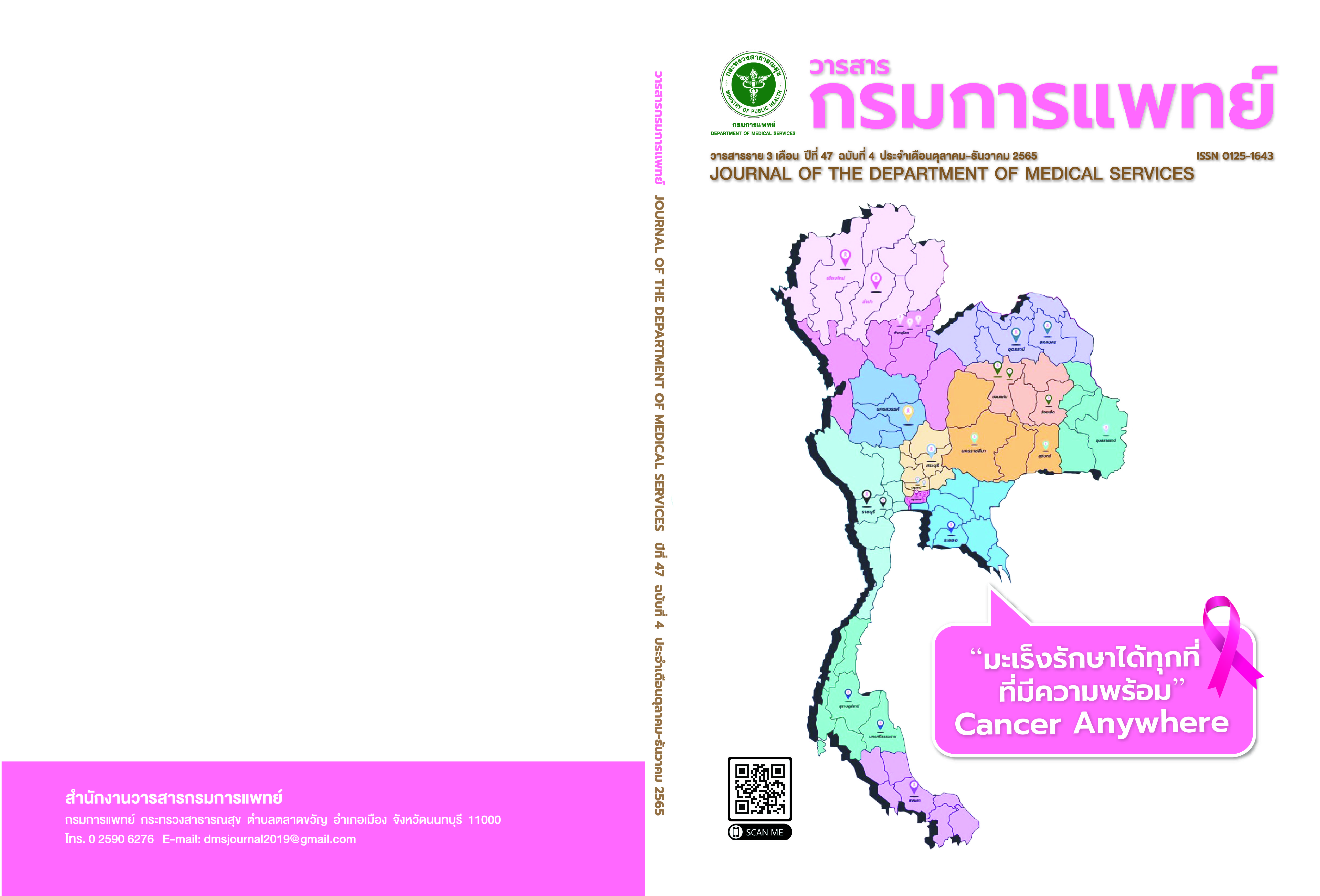การศึกษาเปรียบเทียบผลของยาทาม็อกซิเฟ่น (Tamoxifen) ต่อการเปลี่ยนแปลงภาวะถุงน้ำ (Fibrocystic breast change) ในผู้ป่วยมะเร็งเต้านม
คำสำคัญ:
ภาวะถุงน้ำ, ถุงน้ำธรรมดา, ถุงน้ำขุ่น, ถุงน้ำชนิดซับซ้อนบทคัดย่อ
ภูมิหลัง: ความชุกของภาวะถุงน้ำพบร้อยละ 30-60และถุงน้ำชนิด complex cyst มีความสัมพันธ์กับมะเร็งเต้านมร้อยละ 0.3 โดยถุงน้ำเต้านมมักพบในผู้หญิงในวัยมีประจำเดือนมากกว่าในวัยหมดประจำเดือน หลายการศึกษาพบว่ายาทาม็อกซิเฟ่นลดความเสี่ยงต่อมะเร็งเต้านมและความปวดจากภาวะถุงน้ำ วัตถุประสงค์: เพื่อศึกษาเปรียบเทียบผลของยาทาม็อกซิเฟ่นต่อการเปลี่ยนแปลงของขนาดแลจำนวนของถุงน้ำ วิธีการ: การศึกษาวิเคราะห์แบบย้อนหลังโดยใช้ข้อมูลของผลเอกซเรย์เต้านมและอัลตร้าซาวด์หรืออัลตร้าซาวด์ในผู้ป่วยมะเร็งเต้านมของโรงพยาบาลมะเร็งสุราษฎร์ธานี จำนวน 2,244 รายตั้งแต่เดือนมกราคม พ.ศ. 2551 - กรกฎาคม พ.ศ. 2560 ผล: ผลการศึกษาพบถุงน้ำจำนวน 77 ราย (ร้อยละ 3.43) จากผู้ป่วยจำนวน 2,244 ราย โดยพบมากในช่วงอายุ 41–50 ปี การวิเคราะห์ค่าทางสถิติโดย chi-square- test พบว่ายาทาม็อกซิเฟ่นรวมทั้งภาวะการมีประจำเดือนมีผลต่ออัตราการเล็กลงหรือการลดลงของถุงน้ำไม่ต่างกัน โดย ผู้ป่วยมะเร็งเต้านมที่กินยาทาม็อกซิเฟ่น พบว่าอัตราการเล็กลงของขนาดของถุงน้ำและอัตราการลดลงของจำนวนถุงน้ำในเป็นร้อยละ 60.7 และ 46.4 ตามลำดับ ผู้ป่วยมะเร็งเต้านมที่ไม่ได้กินยาทาม็อกซิเฟ่น พบว่าอัตราการเล็กลงของขนาดของถุงน้ำและอัตราการลดลงของจำนวนของถุงน้ำเป็นร้อยละ 50.0และ 35.3 ตามลำดับ แต่พบว่าไม่มีความแตกต่างอย่างเป็นนัยสำคัญทางสถิติ (p–value: 0.706 และ 0.508 ตามลำดับ) อัตราการเล็กลงของขนาดถุงน้ำในผู้ป่วยมะเร็งเต้านมที่มีประจำเดือนที่กินยาทาม็อกซิเฟ่นและไม่กินยาทาม็อกซิเฟ่น เป็นร้อยละ 50.0 และ50.0 ตามลำดับ (p–value: 0.252) อัตราการเล็กลงของขนาดถุงน้ำในผู้ป่วยที่ไม่มีประจำเดือนที่กินยาทาม็อกซิเฟ่นและไม่กินยาทาม็อกซิเฟ่น เป็นร้อยละ 60.0 และ 55.6 ตามลำดับ (p–value:0.330) อัตราการลดลงของจำนวนถุงน้ำในผู้ป่วยมีประจำเดือนที่กินยาทาม็อกซิเฟ่นและไม่กินยาทาม็อกซิเฟ่นเป็นร้อยละ 55.6 และ25.0 ตามลำดับ (p–value: 0.229) อัตราการลดลงของจำนวนของถุงน้ำในผู้ป่วยที่ไม่มีประจำเดือนที่กินยาทาม็อกซิเฟ่นและไม่กินยาทาม็อกซิเฟ่น เป็นร้อยละ 50.0 และ 44.5 ตามลำดับ (p–value:0.904) สรุป: ยาทาม็อกซิเฟ่นไม่มีผลต่อการลดขนาดของถุงน้ำและไม่มีผลต่อการลดจำนวนของถุงน้ำของเต้านมในผู้ป่วยมะเร็งเต้านมทั้งในกลุ่มที่ยังมีประจำเดือนและกลุ่มที่ไม่มีประจำเดือน
เอกสารอ้างอิง
Malherbe K, Khan M, Fatima S. Fibrocystic breast disease.StatPearls. 2021 Oct 24. PMID: 31869073.
Cole P, Elwood JM, Kaplan SD. Incidence rates and risk factorsof benign breast neoplasms. American Journal of Epidemiology1978; 108: 112-20.
Khanzada TW, Samad A, Sushel C. Spectrum of benign breastdiseases. Professional Medical Publications 2009; 25: 265-8.
Berkowitz GS, Kelsey JL, Holford TR, LiVolsi VA, Merino MJ,Beck GJ, et al. Estrogen replacement therapy and fbrocysticbreast disease in postmenopausal women. American Journal ofEpidemiology 1985; 121: 238-45.
Dupont WD, Page DL. Risk factors for breast cancer in womenwith proliferative breast disease. N Engl J Med. 1985; 312:146-51.
Hartmann LC, Sellers TA, Frost MH, Lingle WL, Degnim AC, GhoshK, et al. Benign breast disease and the risk of breast cancer. NEngl J Med 2005; 353: 229-37
Guray M, Sahin AA. Benign breast diseases: classifcation, diagnosisand management. The oncologist 2006; 11: 435-49
Stachs A, Stubert J, Reimer T, Hartmann S. Benign breast diseasein women. Dtsch Arztebl Int 2019; 116: 565-74.
Devitt JE, To T, Miller AB. Risk of breast cancer in women withbreast cysts. CMAJ 1992; 147: 45-9.
Alipour S, Rastad H, Saberi A, Faiz F , Maleki-Hajiagha A, AbediM. Metformin in the management of fbrocystic breast disease:a placebo-controlled randomized clinical trial. Daru 2021; 29:389-96.
Reifsnider E, MSN, RNC. Educating women about benign breastdisease. AAOHN Journal 1990; 38: 121-6.
Hurst JL, Mega JF, Hogg JP. Tamoxifen-induced regression ofbreast cysts. Journal of Clinical Imaging 1998; 22: 95-8.
Balalau C, Voiculescu S, Motofei I, Scaunsu RV, Negrei C. Lowdose Tamoxifen as treatment of benign breast proliferativelesion. Farmacia 2015; 63: 371-5.
Tan-Chiu E, Wang J, Costantino JP, Paik S, Butch C, WickerhamDL, et al. Effects of Tamoxifen on benign breast disease inwomen at high risk for breast cancer. Journal of the NationalCancer Institute 2003; 95: 302–7.
ดาวน์โหลด
เผยแพร่แล้ว
รูปแบบการอ้างอิง
ฉบับ
ประเภทบทความ
สัญญาอนุญาต
ลิขสิทธิ์ (c) 2022 กรมการแพทย์ กระทรวงสาธารณสุข

อนุญาตภายใต้เงื่อนไข Creative Commons Attribution-NonCommercial-NoDerivatives 4.0 International License.
บทความที่ได้รับการตีพิมพ์เป็นลิขสิทธิ์ของกรมการแพทย์ กระทรวงสาธารณสุข
ข้อความและข้อคิดเห็นต่างๆ เป็นของผู้เขียนบทความ ไม่ใช่ความเห็นของกองบรรณาธิการหรือของวารสารกรมการแพทย์



